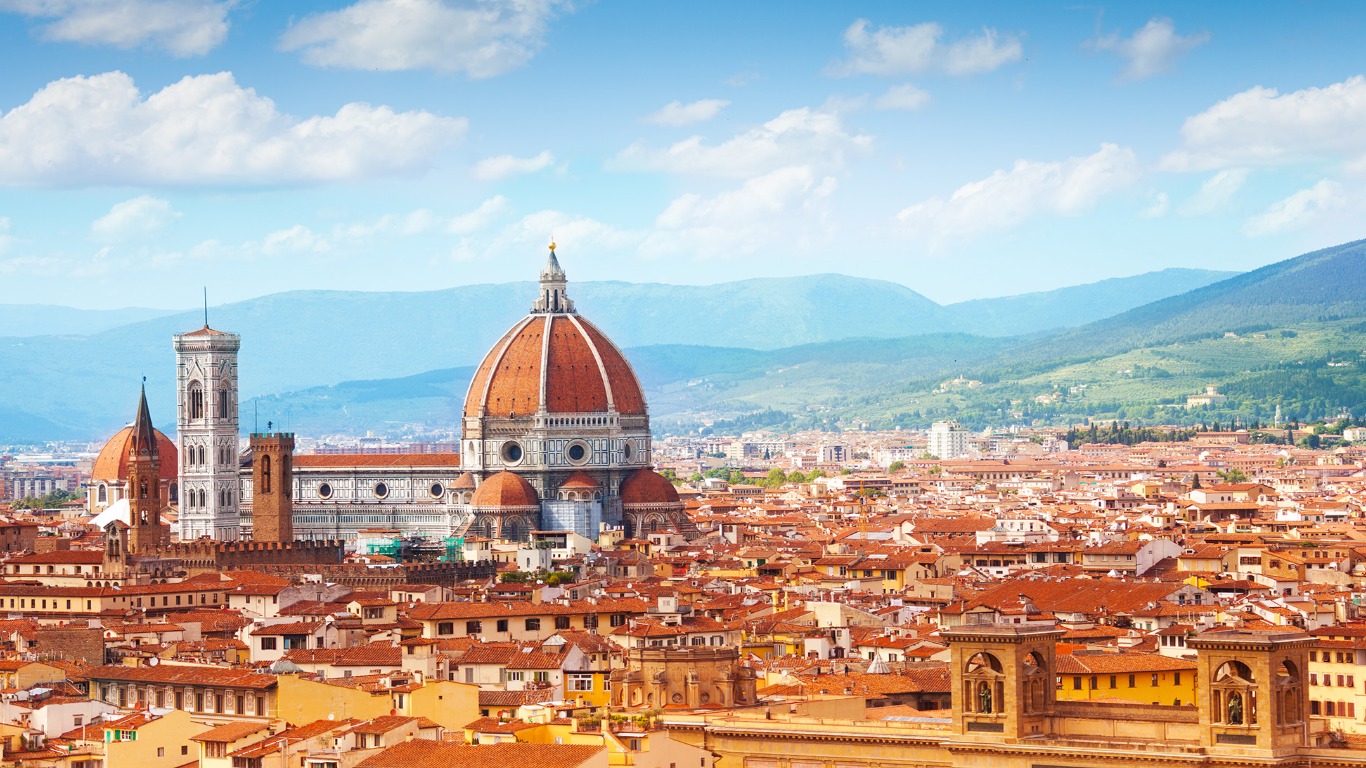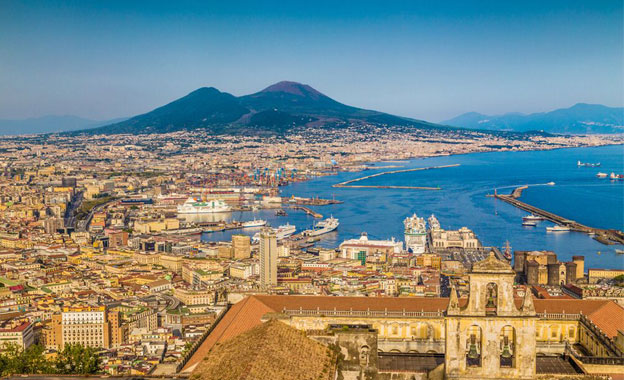

A heady mix of haunting ruins, awe-inspiring art and vibrant street life, Italy’s hot-blooded capital is one of the world’s most romantic and charismatic cities. The result of 3000 years of ad hoc urban development, Rome’s cityscape is an exhilarating sight. Ancient icons such as the Colosseum, Roman Forum and Pantheon recall the city’s golden age as caput mundi (capital of the world), while monumental basilicas tell of its history as seat of the Catholic Church. Lording it over the skyline, St Peter’s Basilica towers over the Vatican, testifying to the ambition of Rome’s Renaissance popes and the genius of its game-changing architects. Elsewhere, ornate piazzas and showy fountains add a baroque flourish to the city’s captivating streets.

Just across the street from our hotel, there is already an archeological site with Roman ruins scattered.

The number one tourist attraction in Rome has to be the Colosseum. Inaugurated in 80 CE, the 50,000-seat Colosseum, also known as the Flavian Amphitheatre, has survived in remarkably good shape. And it doesn’t take a huge leap of the imagination to picture it in its pomp, with its steeply stacked stands full of frenzied spectators as armoured gladiators slug it out on the arena below.

I would recommend going for the normal tickets. We did the all-access pass but it was not worth it. Even though it includes access to the arena and the upper floors of the Colosseum, but the arena was nothing special. For the normal ticket holders, even though they cannot access the arena, but there is another public area on the ground floor where they can see have a view of the Colosseum from the bottom to the top. Tickets have to be purchased in advance online over here (click on the link). It’s possible to access in the Colosseum only at the time chosen during the booking phase and it’s suggested to show up at the entrance 15 minutes before the chosen time. The ticket includes entrance to the Colosseum, Roman Forum and Palatine Hill. Tickets: €16 for adults.

Elsewhere, ornate piazzas and showy fountains add a baroque flourish to the city’s captivating streets. Piazza Navona is home to showy fountains, baroque palazzi and colourful cast of street artists, hawkers and tourists, Even though it was raining in the afternoon when we visited, this square still retained its elegance and there were many tour groups scattered around the square. Built over the 1st-century Stadio di Domiziano, it was paved over in the 15th century and for almost 300 years hosted the city’s main market. Another draw is the historic Christmas market staged in December, which traditionally runs until 6 Jan. However, the Christmas market has been cancelled this year due to Covid-19.

Fontana del Moro is a fountain located at the southern end of the Piazza Navona in Rome, Italy. It represents a Moor, or African, standing in a conch shell, wrestling with a dolphin, surrounded by four Tritons. It is placed in a basin of rose-colored marble.

The grand centrepiece of the square is Bernini’s Fontana dei Quattro Fiumi, a flamboyant fountain featuring an Egyptian obelisk and muscular personifications of the rivers Nile, Ganges, Danube and Plate. According to legend, the Nile figure is shielding his eyes to avoid looking at the Chiesa di Sant’Agnese in Agone, designed by Bernini’s bitter rival Borromini. Hearing the rich histories of these fountains make me gawk in awe at the intricate design of the fountains as I try to understand the perspective of the artist.

Over to Castel Sant’Angelo. The Mausoleum of Hadrian is a towering cylindrical building in Parco Adriano neighbourhood. It was initially commissioned by the Roman Emperor Hadrian as a mausoleum for himself and his family. The building was later used by the popes as a fortress and castle, and is now a museum. Tickets: adults €17.50 or €19 for fast track line.

The Church of the Gesù is the mother church of the Society of Jesus, a Catholic religious order. Officially named Chiesa del Santissimo Nome di Gesù all’Argentina, its facade is “the first truly baroque façade”, introducing the baroque style into architecture. One of the most striking parts of the temple is the ceiling fresco painted by Baciccia (Giovanni Battista Gaulli). The fresco manages to look three dimensional thanks to the wooden figures and stuccos added to the fresco.

The Victor Emmanuel II National Monument, also known as the Mole del Vittoriano or simply Vittoriano, is a large national monument built between 1885 and 1935 to honour Victor Emmanuel II, the first king of a unified Italy, in Rome, Italy. It occupies a site between the Piazza Venezia and the Capitoline Hill. This monument is located near a large roundabout in central Rome, so there is heavy traffic throughout the day. Today, Il Vittoriano contains a museum dedicated to Italian unification, and visitors can climb to the rooftop for sweeping views of the city. Just behind the monument is a separate exhibition space, the Complesso del Vittoriano Ala Brasini, which hosts important art shows in its numerous halls. Tickets: adults €10 with access to the two glass panoramic elevators that take you to the Terrazza delle Quadrighe.


The Trevi Fountain was designed by Italian architect Nicola Salvi and completed by Giuseppe Pannini and several others. Standing 26.3 metres high and 49.15 metres wide, it is the largest Baroque fountain in the city and one of the most famous fountains in the world. Thousands visit the fountain everyday, keeping up with the tradition of tossing a coin into the water to ensure they will return to Rome. I used to do this but now, it seems like it’s not possible to throw coins in the fountain as there is a barricade for the area closest to the fountain. Many tourists were seen taking selfies with the fountain in the background with its beautiful facade.

These are the famous Spanish Steps, located a stone’s throw away from the Trevi Fountain. These steps have an irregular butterfly-shaped design, built in the 18th century at a French diplomat’s request. Contrary to popular belief, the Spanish Steps were not built by the Spanish. The ‘Spanish’ part of the name refers instead to the Spanish Embassy to the Holy See, which would have been located on Piazza di Spagna (literally ‘Spanish Square’) at the base of the monument. Its Italian name is “Scalinata della Trinità dei Monti” and composed of 12 ramps and 135 travertine steps, it is considered the widest and longest staircase of Europe.

For shopaholics, do head over to Via dei Condotti. It is a port of call for those in search of major Italian designers and international design boutiques, from Gucci to Prada to YSL, any brand that you name, they have it here on this shopping street. It has been the centre of Italian fashion and design since 1905 when Bulgari opened its store here. This street also has beautiful historic buildings with great architecture and gorgeous courtyard.
Eating out in Rome
Ginger
Address: Piazza di S. Eustachio, 54, 00186 Roma RM

Ginger is a chic venue offering breakfasts, salads & açai bowls made with superfoods & organic ingredients. We had grilled cod with sauteed kimchi and pistachio sprinkles, a pulled pork burger with potatoes and a super delicious acai berry smoothie. Even though prices here are quite steep, but the quality of the ingredients shines in its presentation and taste.

Emma Pizzeria
Address: Via del Monte della Farina, 28, 00186 Roma RM

Another place we checked out was Emma Pizzeria, located near our hotel. It is a lively eatery with a local menu featuring homemade pasta, pizzas, meat dishes & desserts, plus wine. I had the smoked salmon pizza with the pizza dough made from organic flour.

My partner had the carbonara which she did not enjoy much because the pasta was more than al dente. We are used to eating Italian style al dente pasta, but this was the worst because the ends of the pasta were crispy and so undercooked. Needless to say, she did not finish this dish. The ingredients used in this dish are very simple, but we did not enjoy the pasta. If you ever come to a pizzeria, do take note to stick to the pizzas only, which is what they are known for.
We also tried French cuisine in Rome, which I will detail in another post. Some days, you get too tired of eating the same old pasta or pizza again, which is typical Italian, so we needed a variety of cuisine and decided to check out one of the famous French restaurants in town.

Overall, the 3D2N spent in Rome flew past really quickly. It was my second time to Rome so I kind of knew the main tourist attractions around the city. I got to try new types of food and chic restaurants this time, but I would still need more time to explore the less touristy neighbourhoods. Another gripe was the weather, it rained on all three days that we were there, making it miserable. Many people on the streets were selling umbrellas and raincoats, but luckily we had brought our own. Walking in the rain and trying to avoid the puddles on the floor was also annoying, as our shoes got soaked quickly, and taking photos while trying to balance an umbrella in hand does not make it easy. We hope that the weather will be kinder to us next time when we go back to Rome again.


